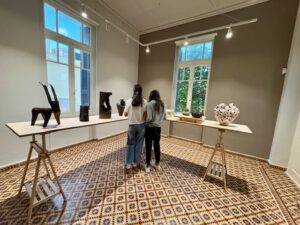During the infamous quarantine of the year 2020, our school together with a talented graphic designer managed to create a private educational environment, specially designed with our learners’ needs in mind and offered it to them free of charge upon their enrollment.
Both in Greek and English, our educational website myschool.markoulaki.gr caters for all the family’s needs. As soon as users, which means both learners and their parents with the same account, log into the platform with a special username and password they have received from the management of the school, they are first exposed to our announcements about various school functions, whether that might be reports, extra lessons or other events our clients need to be aware of. Pop-up windows, banners, and email notifications are merely some of the ways that platform users receive information concerning our school. General information is mostly in Greek so that it is understood by everyone in the family, but other material intended for language use and practice is, of course, in English.
Each user has got specific privileges given by the administrator of the platform who is the manager of the school. The teachers are able to edit blog posts and offer their feedback, upload the new resources and produce new homework boxes. Learners have got access to all these, and are also able to add their own blog posts. Upon entering, students, teachers and administrators have got their own bar with different options at the top of the main webpage, with a unique menu including a series of links chosen particularly for them.
Every family or individual account is given access to a class group depending on the course they are attending in the year. Class groups are of private access so that personal data is protected and language practice is uniquely targeted at each level separately. Each private class group is comprised of certain components: its e-library, homework list and the What’s New section.
Regarding language practice through the platform, each class has got its own privately accessed e-library, with material of its level, this including videos, books, and other useful links and resources that can be downloaded by anyone in the group. The zoom links necessary for online attendance, if the need arises, are permanently exhibited at the top of the e-library, which is very convenient for all users.
One of the main functionalities, however, is the homework list function, which exists separately for each class group. This allows the users of each group to access their homework for every single lesson, enabling the parents to understand the class process, and also absent students to catch up easily. Furthermore, the homework list does not only include conventional homework, but also exciting links to webpages or videos and uploaded teacher resources, this resulting in a paperless classroom.
The great thing about homework lists is that they make for wonderful blended learning. Students are able to view material of all kinds, while preparing for the lesson at home, which the teachers have carefully chosen and posted for them. This allows everyone to prepare fully, and be ready for the new subject matter. Not only are learners capable of anticipating what is to be presented in the next lesson, but they also create their own resources towards that propose; for example, many a time student videos have been posted using the new language even before this is formally presented in class. Various examples can be seen in the resources posted together with this text.
Under each homework box, peer correction can manifest itself. There are many instances where students collaborate to gather a list of resources for the next lesson, give advice to fellow classmates who missed the particular session about a project or other homework that has to be done or even ask a question for other class participants to respond to.
In the What’s New section (Τι Νέα in Greek), all kinds of school announcements are posted, with an all-group notification accompanied by a respective email to all connected user accounts. Another interesting post there includes Google Photos links leading to photographs and videos of our lessons privately shared with the children’s parents, with the latter’s special permission for it. This is an intriguing platform feature offering a glimpse inside our classrooms, which grown ups seem to love.
Notably, there is the ability to write on the blog which is shared and viewed by all class groups. Students are easily turned into bloggers, who share their work online and have a real audience for it. They can also write their own comments or feedback to their fellow classmates, this resulting in a great peer correction and cooperation exercise.
Teachers use the blog extensively, not only to offer their feedback, but also to categorize resources for future use and to post lesson plans and links easily accessed in the classroom and projected on the interactive board. An interesting case in point is student writing on the blog which is viewed and reflected upon by all the class. (See photo.) HTML code can be copied and pasted, as well, so that activities from outside sources can conveniently be embedded into platform blog posts.
What is more, blog posts can be sorted in categories referring to class groups according to the CEFR, which makes it easier for platform users to detect content relevant to their own language level. Post categorization takes place with blog labels, too, denoting a vast number of topics and skills (e.g. writing, speaking, environment, exams). As a result, there can be an advanced search for blog posts regarding the “C2 level” and “Reading” for instance, enabling the easy retrieval of all types of past teacher research.
Last but not least, private messages can be sent by means of the platform, as users have their own email box. Each message can contain text as well as other files, facilitating communication between parents/students and teachers. Depending on the urgency, even class reports have been shared and discussed in this very way.















